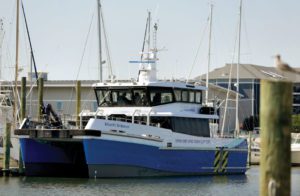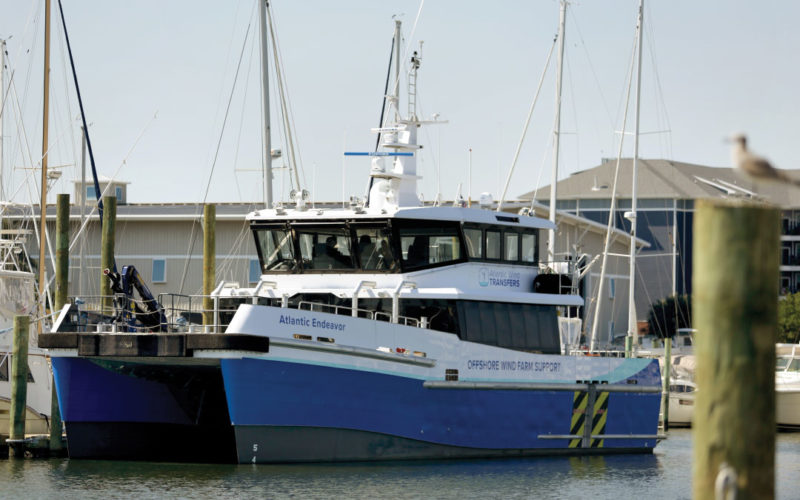
It’s been almost six years since Atlantic Wind Transfers introduced the first offshore wind crew transfer vessel (CTV) in the United States to service the Block Island Wind Farm.
The company’s second CTV, Atlantic Endeavor, entered service in late 2020 with a contract to support the Coastal Virginia Offshore Wind project almost 28 miles off Virginia Beach, Va.
Blount Boats built the new CTV using a 64.9-foot design from Chartwell Marine. It is slightly larger and more resilient than its predecessor, with more deck space, higher freeboard and two additional interceptors installed on the transom. Atlantic Endeavor can transport 24 technicians, nearly twice as many as its sister vessel.
“Atlantic Endeavor sets the new standard for CTVs,” said Charlie Donadio, president and founder of Atlantic Wind Transfers, based in North Kingston, R.I. “It has a higher sea-state capability that will make the vessel more reliable and create a nicer ride for the technicians going back and forth, which helps keep fatigue down.”
Crew transfer vessels, as the name suggests, are designed to safely transport turbine technicians and cargo between shore and offshore wind turbines. Once they reach the site, these specialized vessels line up against the turbine base and then push against it to keep the vessel in place.
The safe transfer of personnel on and off these turbines, in good weather and bad, is the CTV’s most important function, Donadio said.
“The job is safely being able to connect (to the turbine base) and safely transfer passengers,” he said in a recent interview. “It is the ability to connect in challenging sea conditions and minimize slippage, so technicians can transfer on and off to the turbine.”
As of September 2021, only three such vessels are operating in the U.S., and Atlantic Wind Transfers’ CTVs are supporting both existing offshore wind projects. The number of U.S.-based CTVs will grow as more offshore wind projects move closer to construction. Predictions vary, but six or more CTVs could be needed within the next five years.
The next crop of CTVs likely will be longer and outfitted differently, much like the next-generation vessels now operating in Europe servicing bigger wind farms with larger turbines and more of them, Donadio said. He expects future CTV projects to be in the 27-meter (88.5-foot) range.
Atlantic Endeavor, meanwhile, was tailored to the needs of the Coastal Virginia Offshore Wind project developed by Dominion Energy. Atlantic Wind Transfers partnered with Chartwell Marine of Southampton, England, on an aluminum catamaran vessel built to the Chartwell 24 platform.
Andy Page, director and naval architect at Chartwell Marine, designed both of Donadio’s CTVs. The newer one is about 1 meter (3.28 feet) longer and 1.5 meters wider than its predecessor.
“In the five years since (Atlantic Pioneer) was built, one of the things that is most prevalent is visibility while working on these offshore sites,” Page said. “There is a lot going on, especially during construction — SOVs (service operation vessels), wind turbine installation vessels, cable-laying ships, surveying vessels, patrol boats. When you are traveling at relatively high speeds and working with these vessels around you, visibility is absolutely crucial.”
Atlantic Endeavor’s 11.5-foot freeboard is double that of Atlantic Pioneer, which contributes to the newer vessel’s improved resiliency and capabilities in less-than-ideal conditions. “[T]hat’s mostly adding freeboard to reduce wave action on the underside of the catamaran,” Page said, “and to increase the push-on capability of the turbine.”
Atlantic Endeavor’s upper level is home to the wheelhouse and operational center for up to three crewmembers. It typically operates with a two-person crew. Its main deck is outfitted to comfortably carry technicians for the transit back and forth from the turbine site, which takes one hour and 45 minutes.
The lower space includes a wet room, where passengers can change and store personal equipment. From there, they enter a saloon deck with 24 Modell Mobler seats that are wider and more comfortable than those on Atlantic Pioneer. The room has a mix of high-level and low-level LED lighting to accommodate different daylight conditions.
Both levels have full galleys. This allows the crew and passengers to coexist without intruding on one another’s space. “They have their dedicated space where they are working, and the technicians have their dedicated space,” Page said. Atlantic Endeavor has a freshwater capacity of 396 gallons and a sewage capacity of 132 gallons.
The wheelhouse is equipped with four 24-inch Green Marine navigation touch-screen monitors. Its navigational systems include radar, AIS, GPS, satellite link and compass. The port and starboard docking stations allow for “even greater visibility when performing those activities,” Page said.
Donadio described the electronics suite as “state of the art” with redundant radar, navigation and communication capabilities. The components within the wheelhouse were not individually disclosed.
Atlantic Endeavor is propelled by two 1,400-hp MAN main engines powering two HamiltonJet waterjets through ZF gears. Electrical power comes from two 29-kW Cummins Onan gensets, while four Humphree interceptors provide active ride control. The top speed is 28.5 knots, while its cruising speed is closer to 24.
The MAN engines do more than propel the vessel. Their power is needed to push and hold the vessel against the turbine base during crew transfers.
“The percentage of the horsepower they are pushing on is dependent on the sea conditions,” Donadio said.
Atlantic Endeavor has 10 tons of cargo capacity and deck space for two 10-foot cargo containers. The deck is designed to keep these heavy loads safe while underway — but more importantly, out of the operator’s line of sight. Page said he designed the ship deck to reduce trip hazards; for instance, there are no steps or free thresholds on the bow transfer area.
The edges of the ship are covered by a rubber bow fender, which maximizes the boat’s ability to stick to turbine towers and not rise and fall when the waves pass through.
For “man overboard” emergencies, Atlantic Endeavor has a 6.5-foot swing-gate opening from which crews can deploy a Jason’s cradle rescue device. A crane lowers a rescue ring that guides the person to the cradle.
Blount Boats of Warren, R.I., built both of Atlantic Wind Transfers’ CTVs. The overall goal of the project was to update the proven Atlantic Pioneer platform to meet the standards of CTVs operating in European wind farms, said Luther Blount III, project engineer for Blount Boats.
CTVs used in Europe have become increasingly large, swift and powerful, and that similar trend is happening in the United States. “The operators need to get to wind farms as quick as possible,” Blount said. “The boats in Europe are 65 feet long. The trend has been to build bigger and bigger and figure out [adding] 10 knots of speed later.”
“Light, fast and overpowered is the best way to describe them,” he said. •

